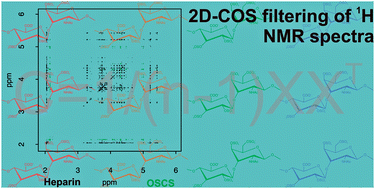High-sensitivity visualisation of contaminants in heparin samples by spectral filtering of 1H NMR spectra†
Abstract
A novel application of two-dimensional correlation analysis has been employed to filter

* Corresponding authors
a Istituto di Ricerche Chimiche e Biochimiche ‘G. Ronzoni’, Via Giuseppe Colombo, 81 Milano 20133, Italy
b
School of Biological Sciences, University of Liverpool, P.O. Box 147, Liverpool, UK
E-mail:
eayates@liv.ac.uk
Tel: +00 44 (0)151 795 4429
c UNIFESP – Universidade Federal de São Paulo, Departamento de Bioquímica, Disciplina de Biologia Molecular, Rua Três de Maio 100, 4 andar – Vila Clementino, 04044-020 Brazil
d Institute for Science and Technology in Medicine, Keele University Keele, Staffordshire, UK
e National Institute for Biological Standards and Control, South Mimms, Potters Bar, Hertfordshire, UK
A novel application of two-dimensional correlation analysis has been employed to filter

 Please wait while we load your content...
Something went wrong. Try again?
Please wait while we load your content...
Something went wrong. Try again?
T. R. Rudd, D. Gaudesi, M. A. Lima, M. A. Skidmore, B. Mulloy, G. Torri, H. B. Nader, M. Guerrini and E. A. Yates, Analyst, 2011, 136, 1390 DOI: 10.1039/C0AN00835D
To request permission to reproduce material from this article, please go to the Copyright Clearance Center request page.
If you are an author contributing to an RSC publication, you do not need to request permission provided correct acknowledgement is given.
If you are the author of this article, you do not need to request permission to reproduce figures and diagrams provided correct acknowledgement is given. If you want to reproduce the whole article in a third-party publication (excluding your thesis/dissertation for which permission is not required) please go to the Copyright Clearance Center request page.
Read more about how to correctly acknowledge RSC content.
 Fetching data from CrossRef.
Fetching data from CrossRef.
This may take some time to load.
Loading related content
